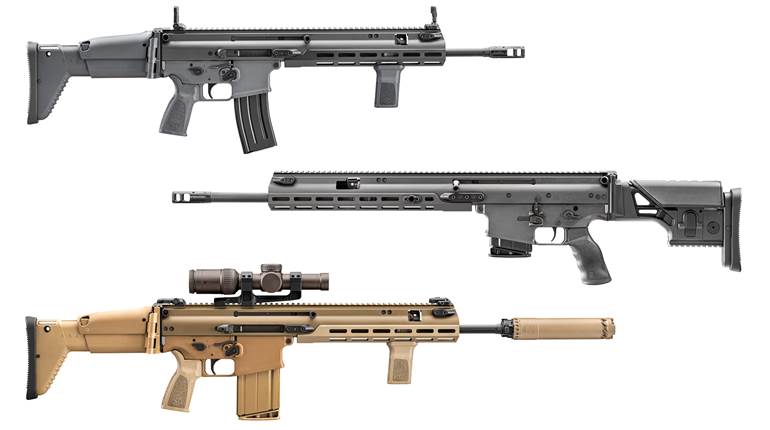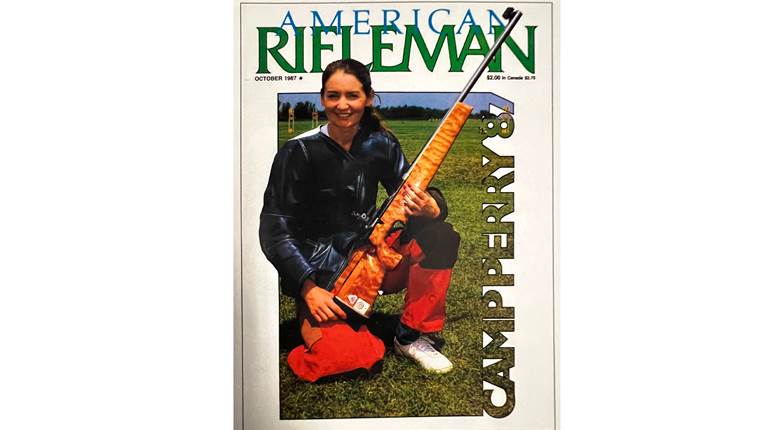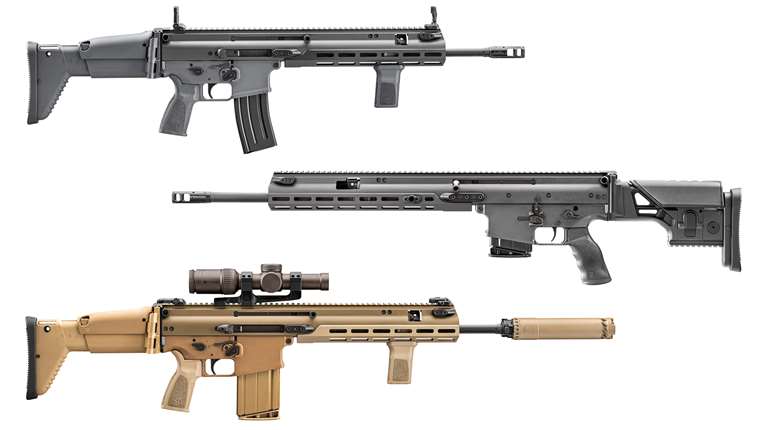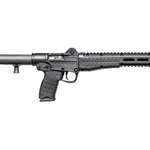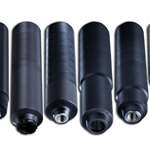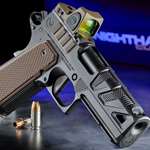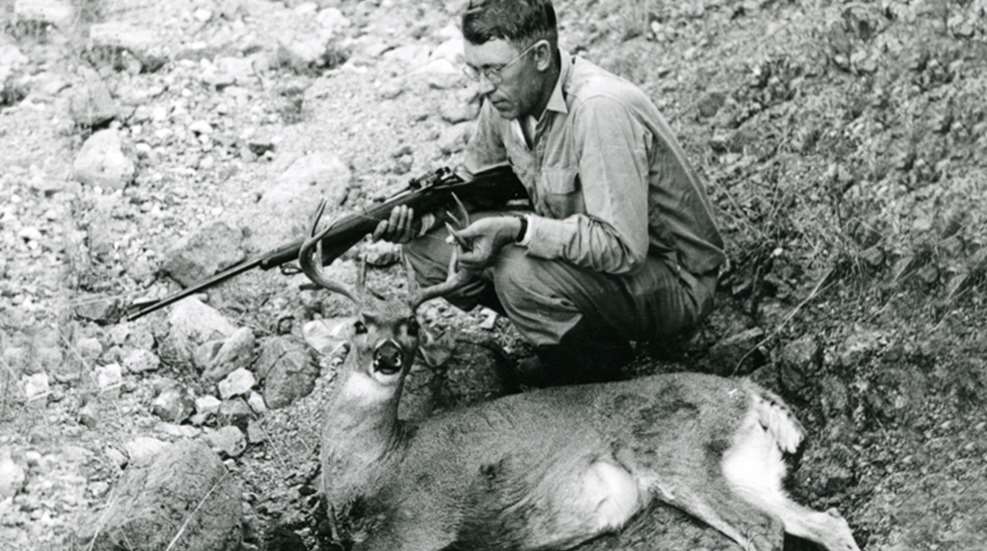
Jack O’Connor was in his early 20s when he acquired his first .270 Win. rifle, but some years would pass before he became the champion of that cartridge. It's not certain which rifle is pictured here, but it appears to be a Springfield action, likely in .30-'06 Sprg. The deer is a nice Coues whitetail from O’Connor’s native Southwest.
100 years ago, the .270 Winchester cartridge—commonly abbreviated “.270 Win.” or referred to simply as the “.270”—was introduced in the Model 54 bolt-action. Based on a simple necking down of the .30-’06 Sprg. case, the .270 Win. was very fast for 1925, but its velocity was not unprecedented. A decade earlier the Charles Newton-designed .250 Savage became the first commercial cartridge to break 3000 feet per second (f.p.s.). Other earlier cartridges came very close, including Newton’s own .256 and .30 Newton; the Canadian .280 Ross; and the British .275 H&H Mag. The .270 Win. got there solidly and with authority—a 130-gr. bullet, originally advertised at 3100 f.p.s.
It’s probably an exaggeration to say that it took the shooting world by storm. The cartridge did get noticed, but it wasn’t all good. Velocity probably exceeded 1925 hunting bullet technology; there were complaints, no doubt true, about explosive effect and excessive meat damage. Also, in a time when very few shooters used scopes, one must question the relevance of a flattened trajectory. In time, however, the .270 caught on. As a sporting cartridge, it has never quite equaled the popularity of its parent, the .30-’06 Sprg., but it has come close and, despite generations of fast magnums that have followed, it remains a perennial favorite.
Splitting Hairs: The .277"
It is said that development of the .270 began in 1923. Surely the Winchester engineers didn’t pull the bullet diameter out of thin air, so at that time their reason for settling on .277" must have been based on some sort of rationale. Unfortunately, it seems to have been lost to the sands of time. Even then, most of today’s “standard” bullet diameters were already in common use. Using the British convention of measuring bore diameter across the grooves rather than the lands, the .256 Newton was actually a 6.5 mm, caliber .264. Similarly, the .275 H&H Mag. was a 7 mm, bullet diameter .284". Two experimental military cartridges of the day, the British .276 Enfield and American .276 Pedersen, were also more or less 7 mms. The .270 Win. was the first Western cartridge to use a .277" bullet.
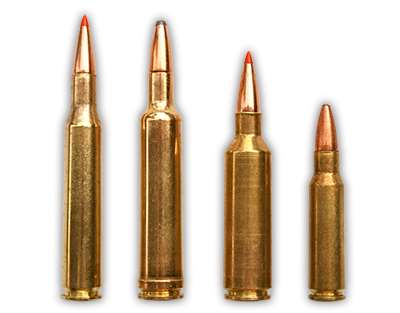
If you think about it, it’s an odd choice: The difference between .277 and the 7 mm is just 0.007", truly not enough to argue about. The difference between the .270 and the 6.5 mm is a bit more, 0.013", but still hardly enough to get worked up over. Frank C. Barnes’ Cartridges of the World suggests that there was an experimental Mauser military cartridge developed for China that used the .277" bullet diameter, theoretically the 6.8x57 mm Mauser. Although apparently chambered by both Mauser and Mannlicher before World War I, the cartridge is so obscure that my research turned up not a single photograph—even Barnes’ exhaustive work has no photo. In the 1920s we were practicing gunboat diplomacy in China, so although it’s possible Winchester knew of this .277", it seems unlikely.
It does seem that the company's goal was to increase velocity and flatten trajectory by necking down the .30-’06 Sprg. case—perhaps with an eye toward reducing recoil as well (which is part of what the .276 Pedersen experiment was about). An Internet search turned up several interesting comments, including that the 6.5 mm and 7 mm were “European” bullet diameters, both with numerous cartridges and case dimensions already on the market, but unlikely to sell well in post-World War I America. And there was one incredibly simple explanation that never, ever crossed my mind: Multiply our popular .308" diameter by 0.90, and the result is .277". So .270" is 90 percent of, or 10 percent smaller in diameter than, the then-standard .30 caliber. Perhaps that is coincidence and the explanation remains lost—or perhaps that 10 percent represented the engineering design goal.
Whatever the case, it worked. It worked so well and became so popular that, unlike most standard bullet diameters, the .277" has never proliferated into a wide array of cartridges. In fact, there are just three other cartridges that share this bullet diameter. The .270 Wby. Mag., developed in 1943, was actually the first of what would become Roy Weatherby’s line of magnum cartridges. In 2002, Winchester necked down its .300 Winchester Short Magnum case to .270" and 7 mm, simultaneously introducing the .270 and 7 mm WSMs. Although neither have been wildly popular, both the .270 Wby. Mag. and .270 WSM are good cartridges, faster and flatter-shooting than the .270 Win., and delivering noticeably more bullet energy. Also, in 2002 Remington began work with SOCOM (Special Operations Command) to develop the 6.8x43 mm Special Purpose Cartridge (SPC). Based on the old .30 Rem. case, this “.270” was designed to fit into the AR-15/M16 action, delivering more energy than the 5.56x45 mm NATO. Acceptance by the military has been limited, but the cartridge has gained acceptance among hunters who choose the AR platform. As for the original .270, well, it just keeps rolling along.
The O’Connor Connection
Jack O’Connor was among the early buyers of the Winchester Model 54 in .270 Win. Just 23 in 1925, he hadn’t yet returned to his native Arizona. When he got that first .270 Win., he might have been attending his last year of college in Arkansas, it might have been during a brief stint as a cub reporter in Chicago, or he might have been doing post-graduate school in Missouri, but he was not the legendary outdoor writer he would become. He was also not a sheep hunter, not quite yet. His first sheep hunt was in Sonora in the blistering August of 1934. He was accompanied by one of his English students, my uncle, Art Popham. O’Connor didn’t get a ram on that hunt; he went back a few months later and took his first desert bighorn, and of course went on to take many more wild sheep.
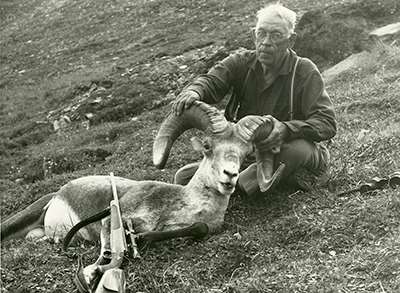
My uncle was successful, and wrote a great story about the hunt, “Ram from Inferno,” originally published in Outdoor Life and included in his book and one of mine. Unfortunately, he didn’t mention whether O’Connor carried a .270 Win. on that hunt, and that’s a question I wish I had asked. It was a good question, because although O’Connor and the .270 Win. are inextricably linked, in the 1930s and even into the 1940s his use of the .270 wasn’t as exclusive as legend has it. In his earlier days he was a fan of the .30-’06 Sprg. (like most Americans of his day), and he also liked the .257 Roberts and 7x57 mm Mauser. In truth, his use of the .270 was never exclusive. As a gunwriter with obligations, he used a lot of cartridges. He is known to have taken one desert ram with a Winchester Model 71 in .348 Win., and by choice and preference he used much larger cartridges for much larger game, including the .375 H&H Mag., .416 Rigby and wildcat .450 Watts.
That said, O’Connor did love the .270! By the early 1950s he was our best-known gunwriter—with enough clout to use the rifles he preferred (at least most of the time). More often than not he chose the .270, carrying it on numerous sheep hunts in western Canada. This meant that his .270s also accounted for several moose and grizzlies, along with goats and caribou. Although he took larger calibers for the dangerous game, the .270 was his preferred light rifle in Africa, accounting for a wide variety of game on his several safaris. He used a .375 on his tiger hunt in India, but the .270 was his choice on his shikars to the mountains of Iran.
In 1948 the O’Connors moved from Arizona to Lewiston, Idaho, and of course his .270s went with him, continuing to account for elk, mule deer and more. At the end he remained faithful, carrying his beloved and famous Al Biesen-stocked .270 “Number 2” on his last sheep hunts in the early ’70s, and for the hunting he was still able to do as his health declined. I believe the .270 Win. would have been a success without O’Connor’s help, but their stars rose together, and the .270 continues to shine brightly now 38 years after his passing.
O'Connor Had It Mostly Right
There are many great cartridges, but in O’Connor’s era it was “normal” for a gunwriter to champion a favorite. Col. Townsend Whelen was a .30-’06 Sprg. man; Warren Page was a 7 mm man; Elmer Keith loved the .33s; Col. Charles Askins chose the 8 mms. When I started, the likely choices were all taken. I did have a .270 in my late teens and 20s. It saw a lot of use and served me well, but I didn’t write about it much because, after all, what fledgling writer would dare to address Jack O’Connor’s cartridge?
Years later, in the ’90s, the .270 Win. was a cartridge I circled back to. I have never been exclusive with any cartridge, and I admit to some oddball favorites, but the .270 is a cartridge and caliber I keep returning to. Over the years I’ve used it on all the continents, taking a wide variety of sheep, goats, deer and antelope. There was a time when I questioned its adequacy for elk, leaning more toward the Elmer Keith school. I’ve gotten past that. Elk are tough, and you must be careful about bullet placement no matter what you use, but the .270 is enough gun, and even better today than in O’Connor’s time because we have better bullets. The .270 worked fine on the longest shot I’ve ever made on an elk, 405 yds., with a classic load consisting of a handloaded 150-gr. Nosler Partition. It worked equally well on a huge-bodied Anatolian stag in Turkey, at a similar distance, with a then-new Hornady GMX.
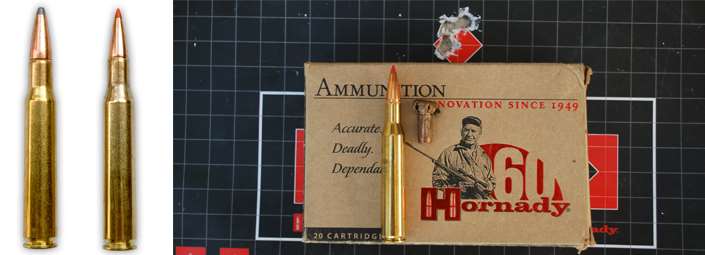
As for smaller game, the .270’s never had a problem. I still don’t think it’s perfect for elk, nor perfect for moose, and certainly not a wise choice for grizzly. But it’s amazing what it can do, and what it will do—without obnoxious recoil or blast. My wife, Donna, uses it almost exclusively (she can, she’s not a writer!), and has used it to take game up to the size of elk and the heavier African plains game such as kudu, zebra and wildebeest. Even in her very light MGA .270, the recoil is mild; for most of us, whether we like to admit it or not, shootability has much to do with shot placement.
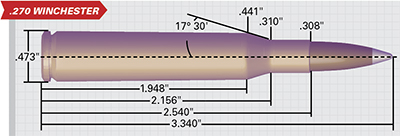 O’Connor used mostly 130-gr. bullets, now standard at 3060 f.p.s. I messed around with 150-gr. bullets for a time, now standard at 2850 f.p.s., but for years compromised on the 140-gr. bullet, rare in O’Connor’s day. Somehow that extra 10 grs. gave me a bit more confidence, and it always worked well. Now I’ve circled back on bullets as well; today we usually shoot 130-gr. bullets. Standard factory loads are plenty fast and plenty flat, but it’s no great trick handloading up to 3100 f.p.s. and change. And there are faster loads out there. Hornady’s Superformance with 130-gr. GMX is rated at 3190 f.p.s., which is getting into .270 WSM territory. And of course the tough homogenous bullets like the GMX and Barnes TSX will hold together and penetrate, even at the highest velocities. They are good choices for larger, tougher game.
O’Connor used mostly 130-gr. bullets, now standard at 3060 f.p.s. I messed around with 150-gr. bullets for a time, now standard at 2850 f.p.s., but for years compromised on the 140-gr. bullet, rare in O’Connor’s day. Somehow that extra 10 grs. gave me a bit more confidence, and it always worked well. Now I’ve circled back on bullets as well; today we usually shoot 130-gr. bullets. Standard factory loads are plenty fast and plenty flat, but it’s no great trick handloading up to 3100 f.p.s. and change. And there are faster loads out there. Hornady’s Superformance with 130-gr. GMX is rated at 3190 f.p.s., which is getting into .270 WSM territory. And of course the tough homogenous bullets like the GMX and Barnes TSX will hold together and penetrate, even at the highest velocities. They are good choices for larger, tougher game.
The one fly in the .270’s ointment is accuracy. Don’t get me wrong: Most .270s are plenty accurate for any and all hunting purposes, but that’s the point: For 91 years the .270 has been considered primarily a hunting cartridge. It is almost never considered a tack-driving winner of matches. From my standpoint, that’s odd. Over the years I’ve shot a lot of very good groups with several .270s, and have found most to be not only fairly accurate, but also quite tolerant, and not too finicky about loads. But here’s reality: Very few match-grade bullets, and almost no match-grade ammunition, have ever been produced in .270. Likewise, very few match-grade .270 Win. rifles have ever been made. For a short time Winchester offered its Model 70 Target in .270, but orders were so sparse they dropped the chambering. As gunwriter Jim Carmichel (who succeeded O’Connor as shooting editor of Outdoor Life) recounted, Tim McCormack, long-time head of Remington’s Custom Shop, doesn’t recall getting a single order for a Model 40-XB in .270 Winchester.
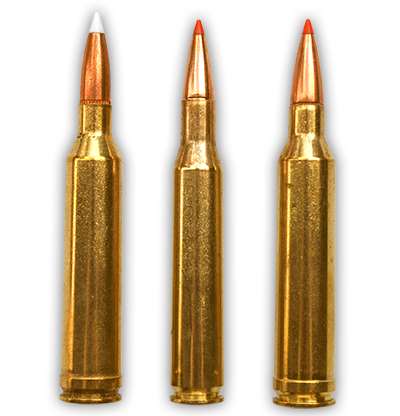
The .30-cal. was once the darling of the long-range accuracy crowd and it remains America’s most popular rifle bullet diameter. Nonetheless, while the 6.5 mm has never achieved general popularity in this country, a lot of 1,000-yd. shooters turned from .30-calibers to efficient 6.5s such as the 6.5-.284 Norma and the 6.5 mm Creedmoor. They remain supersonic beyond 1,000 yds., but are a lot easier to shoot than the heavier .30s. For the same reasons, various 7 mms have some popularity with the long-range group. Of course many hunters love the 7 mm, and Lord knows there are plenty of 7 mm cartridges to choose from. The .270 remains almost entirely a hunter’s caliber, and the .270 Win. remains the most traditional choice. It doesn’t win long-range matches, not because it couldn’t, but because it’s never been asked to. And since it hasn’t been asked, the bullet choices to make it a contender don’t exist. Sierra has a 135-gr. .277 MatchKing, but it has never sold well. Berger, with perhaps the most extensive line of match-grade bullets, offers three VLD hunting bullets in .277, but no match bullets. In the field, however, the .270 will accomplish any reasonable task it is asked to perform at any reasonable range.
O’Connor was in his prime when the .264 Win. Mag. burst onto the scene in 1958. He damned it with faint praise, saying that it wouldn’t do anything his .270 wouldn’t do. I have a soft spot for the unloved .264, but, from the standpoint of experience with both cartridges, I must admit that O’Connor was right. He said pretty much the same thing when the 7 mm Rem. Mag. came out in 1962. Remembering that very slight 0.007" difference, and again having a lot of experience with both cartridges, I have to agree that, once again, O’Connor had it right.
This is the stuff campfire discussions are made of, and we can argue endlessly that the 6.5 mm’s greater sectional density and higher ballistic coefficient prevail or that the heavier bullets available in 7 mm are game-changers. At the 1,000-yd. line with the best match loads, maybe. In the field, within normal ranges, the differences are hair-splitting. Both the 6.5 mm and the 7 mm are great calibers, but the .270 will “git ’er done” just like it has for more than 90 years.












